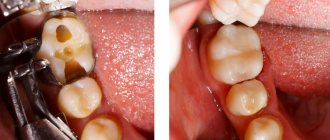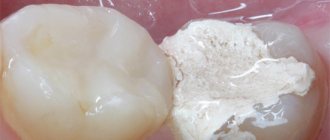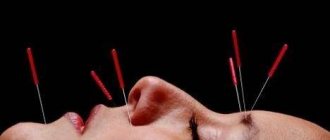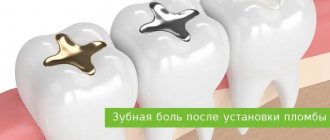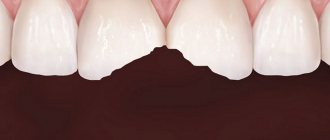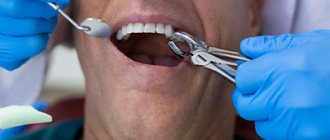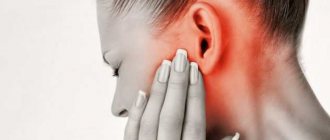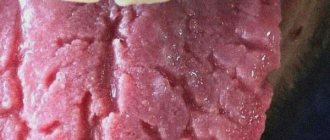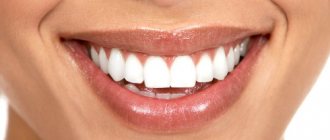Clinic “No Hurt!”
Enlarge
A patient comes to the doctor with caries. Or, during an examination, the doctor discovers caries. Treatment is prescribed. Dental tissue damaged by infection is removed and the tooth geometry is restored using a filling. The nerve of the tooth is not affected during caries treatment and the tooth remains alive. The patient goes home, but the tooth does not allow itself to be forgotten. It hurts to bite. It hurts to chew. Pain occurs when biting, pressing, or pressing on a tooth.
We addressed this topic in the article Tooth hurts after filling. In this publication we will reveal the causes of toothache under a filling after caries treatment.
What can hurt after filling?
The pain associated with the installation of a filling directly depends on the structure of the tooth. It consists of a crown, neck and root. On top, all these structures are covered with hard dental tissues that do not have nerve endings. In the crown area it is dentin and enamel, in the root area it is cement. Inside, under the hard covering in the crown area, there is a dental cavity filled with pulp - a pulp that has many nerve endings and blood vessels. The cavity is connected to root canals, also filled with pulp. In the area of the apex (apex), the root is connected to the bone tissue of the jaw using a ligament - the periodontal ligament, which has excellent innervation.
Conclusion: a tooth can only hurt if the pulp and periodontium are diseased or injured during filling.
Canal cleaning and filling
The most common cause is caries - a pathological process accompanied by the destruction of hard dental tissues. This opens access to the dental cavity, root canals and periodontal tissue, inflammation or irritation of which causes severe pain.
Preparing a tooth for filling
Filling is a method of treating caries, but this process itself can cause mechanical irritation of soft tissues, accompanied by pain. Minor pain may be normal, but sometimes you cannot do without the help of a specialist.
In the superficial and middle stages of caries, the affected hard tissues are removed and a filling is placed on top, restoring the shape of the tooth. The dental cavity remains closed. This treatment is absolutely painless and does not require anesthesia. An even more effective way is to have your teeth professionally cleaned to remove plaque and tartar. Regular implementation of this procedure prevents the development of caries and allows you to keep all your teeth healthy for a long time.
Tooth preparation and depulpation
With deep caries, a hole forms in the hard tissues and an infection enters the dental cavity, causing intense pain. In such cases, before filling, preparation is carried out to remove damaged hard tissues and expand the cavity. If necessary, the old filling is also removed. Then the pulp is removed (depulping).
This is a painful procedure, but modern local anesthetics used in dentistry allow the patient to experience no pain at all. If deep caries has developed not so long ago, and the periodontal tissues are healthy, then it is possible to remove only the pulp from the dental cavity (amputation), after which a therapeutic lining is applied and a temporary filling is installed. If there is no pain, a permanent filling is placed after a few days.
In case of long-standing caries, the pulp is first completely removed from the dental cavity, and then from the root canals (extirpation). At the same time, the cost of filling increases.
It is very important to carefully remove the pulp (patients often call it the nerve) from the canal, making sure that no particles of destroyed hard tooth tissue remain in it. All this can support a long-term inflammatory process.
If a tooth hurts after canal filling, the infection can gradually reach the root apex, causing an inflammatory process in the periodontium, accompanied by fever and pain.
Caries
If after treatment the tooth hurts when pressing or eating, this is considered normal and can persist for up to two months. This is explained by the fact that with deep caries, a very thin layer of dentin remains between the pulp and the filling, so when pressing or biting, pressure is transferred to the nervous tissue and causes pain.
In addition, the patient may experience dull pain for 14 days. This is also considered normal and is explained by a reaction to the use of boron, as well as various medications. But, if even after two weeks the discomfort does not go away, you need to contact your dentist.
Acute or throbbing pain is a reason to visit the dentist immediately: perhaps a carious infection has penetrated into the pulp, causing pulpitis. The sooner you do this, the higher the chance of avoiding the removal procedure and the subsequent need for prosthetics. You can learn how to avoid caries from the article “Prevention of caries.”
Why does a tooth hurt after filling?
If a tooth hurts under a filling, there are usually natural reasons for this - irritation and even a slight aseptic (without infection) inflammatory process. The tooth should hurt after filling. Pain appears after the anesthetic wears off and is associated with restoration of tissue sensitivity. Each patient’s pain sensitivity threshold is different: one feels almost no discomfort, while another perceives the same pain as severe.
Depending on the degree of destruction of the crown and the filling work performed, unpleasant painful sensations after the end of anesthesia can last from 5 days to several months. The doctor must warn the patient that he may be bothered by painful sensations for a certain time and how to cope with them.
There is no need to see a dentist if the pain:
- has a moderate aching character, lasts no more than 5 days and its intensity gradually decreases; during root canal treatment, pain can last from a week to a month; if the filling was traumatic, it may last even longer;
- appears or intensifies when pressing on the filling - biting on solid food;
- associated with eating irritating foods - too cold or hot, as well as sour or sweet; after the effect of irritation ends, the intensity of painful sensations decreases;
- associated with hypothermia;
- is not accompanied by swelling of the cheeks, increased body temperature and a violation of the general condition.
Pain associated with filling errors
Common mistakes: root canal perforation and foreign body entry into the root canal
Post-filling pain syndrome can also be associated with medical errors. This:
- Lack of x-ray examination at the very beginning, before filling . The tooth may have structural features: tortuous canals, the presence of additional canals, etc. Without X-rays, the doctor will not be able to properly process and seal it. This is where the answer to the question of why a tooth hurts after root canal filling lies.
- Incorrect (insufficient or excessive) drying of the prepared cavity . Drying is necessary so that the application of a special solution promotes tight adhesion of the filling material to the dentin of the dental cavity. Insufficient drying leads to disruption of this adhesion, the filling will not fit tightly to the walls, infection will penetrate into the cavity, and inflammation will begin. Overdrying is also harmful, it increases the sensitivity of tissues and post-filling pain syndrome will persist for a long time.
- Overheating of dental tissues. Most often, this complication occurs when the dentist works on old equipment. Tooth preparation is accompanied by strong heating of the bur. If you do not frequently cool the dental tissues, a burn of the pulp or dentin is possible, accompanied by severe pain. Tissue burns are also possible when filling using light-curing filling material and outdated ultraviolet lamps that have not been used for a long time. Modern halogen systems for light curing do not give rise to such complications.
- Failure to comply with preparation rules. Leads to infection, the development of pulpitis and periodontitis and associated pain, which intensifies when biting hard food, perforation may occur: the walls or bottom of the dental cavity; this complication occurs when the walls of the carious cavity are excessively prepared; the bottom of the cavity is most often perforated due to insufficient preparation of the walls, the inability to see and properly process the mouths of the root canals;
- walls of root canals - perforation is usually associated with instrumental treatment of difficult tortuous canals. To reduce pain, you will need to apply therapeutic bandages and completely re-treat the tooth.
- a fragment of a tool used to clean the canal;
To determine why a tooth hurts after filling, specialists at the YuliStom clinic first conduct diagnostics (thorough examination and x-rays) and only then treat.
Possible reasons
Toothache under a filling can be both infectious and traumatic in nature, that is, it usually occurs either due to bacteria that cause inflammation entering sensitive soft tissues, or due to some mechanical impact.
In general, the tooth itself cannot hurt, since it consists of bone tissue, which, by definition, is not sensitive to pain. However, the pulp tissue in its cavity contains a large number of nerve endings that signal the brain about the presence of problems in the damaged area. This is why it so often happens that even a treated tooth ache under the filling. When pathogenic bacteria enter the pulp, it begins to become inflamed and cause severe pain. If you have already gone to the dentist once for treatment of a bad tooth, then repeated pain may occur for the following reasons:
- If the area damaged by caries is not thoroughly cleaned or a leaky filling is installed, a repeated carious process may develop, which, due to favorable conditions, will progress much faster. Usually, such mistakes do not happen when you contact a good specialist from a trusted clinic. So, if after treatment you are experiencing severe pain for a long time, especially if it is a filling on a front tooth, you should immediately make an appointment for a follow-up appointment. In advanced cases, the tooth will have to be removed. Fillings on the front teeth must be installed with special care and precision!
- Sometimes it happens that deep caries has already damaged the layer of dentin under the enamel, and the infection has spread further to the soft tissues, however, severe pain has not yet begun. The doctor removes the damaged area of enamel and fills the cavity. You return home, the anesthesia wears off and, perhaps immediately, or perhaps after a few days, you realize that your tooth hurts very badly under the filling. This means that the inflammatory process in the pulp has already reached the nerve endings, i.e. you have started to experience pulpitis.
- There is another situation. Let’s say a doctor has cured an advanced form of pulpitis, but the inflammatory process has already moved to a deeper level and has entered the periodontal area through the apical foramen in the root. Thus, if you have a toothache under a filling, and the nerve has been removed, there is a possibility of periodontitis.
- Another very unpleasant consequence of advanced forms of inflammation is a cyst. Most often, it grows for months, or even years, completely painlessly, while destroying the bone tissue of the jaw so much that it can no longer be restored without resorting to surgical intervention. So if your tooth hurts after a filling, do not put off going to the dentist, because this can result in very disastrous consequences.
- An allergic reaction to the components of a filling substance is not uncommon these days. Nowadays, new drugs are increasingly appearing that make it possible to reduce the patient’s treatment period to a minimum, but some of them contain potent components that can cause, among other things, irritation. If suddenly, one or two days after treatment, a tooth ache under the filling, perhaps the culprit is intolerance to some substance. Often this pain is accompanied by other symptoms that make it possible to diagnose an allergic reaction.
- Does a tooth under a filling react to cold, hot or pressure with aching pain? Possible reasons: shrinkage due to the use of low-quality material or left unfilled cavities, as well as the exit of filling material into the periodontium through the apical foramen. To avoid such a situation, it is recommended to contact only trusted dentists who have an X-ray machine at their disposal.
- No one is immune from mistakes, so even the best dentist can have trouble. Often it is necessary to clean the tooth canals from pulp residues with very thin instruments. If your tooth aches after filling, a possible cause may be a small piece of needle or drill tip remaining inside. An x-ray will allow you to rule out this possibility.
- And, of course, non-compliance with the doctor’s recommendations, as well as hygiene rules, can lead to painful sensations.
What to do if your tooth hurts after filling?
If a tooth begins to hurt due to a filling being placed, but its condition does not require additional dental procedures to relieve severe pain, the doctor may prescribe:
- painkillers ; most often these are drugs from the group of non-steroidal anti-inflammatory drugs (NSAIDs); Ketoprofen (Ketonal) has the best analgesic properties; in case of severe pain, it is enough to take a long-acting capsule of 150 mg - these will relieve pain for a day; instead of Ketonal, you can use the rectal suppository Diclofenac - 100 mg; both drugs are contraindicated in the presence of a gastrointestinal ulcer; in such cases, it is better to take a nimesulide tablet (Nise) - it has almost no negative effect on the gastrointestinal tract;
- physiotherapeutic procedures - to reduce pain, electrophoresis with novocaine is prescribed; for swelling, it is better to use hydrocortisone instead of novocaine; Magnetic and laser therapy are also used; the number of procedures depends on the patient’s condition;
- a one-time injection of an antibiotic solution into the periodontal tissues - for problematic traumatic treatment to prevent infectious inflammation and pain.
There are many folk recipes for relieving severe post-filling toothache:
- rinsing the mouth with a decoction of oak bark; Pour 2 tablespoons of crushed bark into a glass of water, bring to a boil, boil for 15 minutes, add boiled water to the original volume, strain and rinse your mouth several times a day; when a tooth hurts, it relieves inflammation, swelling and associated pain well;
- applying a small piece of salted (but not smoked) lard to the gum - this application is especially helpful for pain associated with tissue swelling: salt draws fluid from the tissue, swelling and pain go away;
- a reflex method of pain relief (used in folk medicine for a very long time): grate a clove of garlic on a fine grater, place it in a thin napkin, apply it to the inside of the wrist of the hand opposite the painful tooth, fix it and leave it overnight.
Pain in a tooth under a filling: how to distinguish normal from pathology
Toothache after a recent filling may be normal. The fact is that during tooth depulpation (pulp removal), mechanical irritation of the tissue occurs. Using dental instruments, the doctor cleans and widens the canals, and then tightly fills them with filling material. Despite the fact that the treatment is carried out using anesthesia, when the effect of the anesthetic wears off, aching pain is felt.
In what cases is post-filling pain normal:
- has a moderate aching character;
- its intensity gradually decreases;
- not accompanied by swelling or the formation of a purulent focus;
- The general condition of the body is satisfactory, there is no temperature.
Most likely, such pain will completely disappear within 3-7 days, when the tissues are restored and the permanent filling “settles down”.
It is not always possible to complete the treatment of pulpitis that causes toothache in one session. Sometimes the doctor is forced to install a temporary filling to see how the tooth will behave. Under a temporary filling, the tooth may also hurt. Reasons for this:
- exposure to the drug that impregnates the temporary filling;
- allergic reaction to temporary materials;
- mechanical impact on the pulp (the temporary filling is too soft and does not protect the pulp from pressure during eating).
You cannot walk with a temporary filling for a long time. Within 3-5 days, the doctor will replace it with a permanent one and the painful sensations will stop.
If the pain after completing dental treatment is intense, increases at night and is accompanied by swelling of the gums and cheeks, you cannot wait, you need to see a doctor again. This is evidence of a pathological process.
A visit to the dentist is also necessary if a tooth that has been filled for a long time becomes ill. Pain indicates the development of a pathological process under the filling. The exact cause will be determined after an in-person examination and diagnostic procedures.
When you can and when you can’t tolerate pain after filling
My tooth hurts under a filling, what should I do? First of all, do not panic, but calmly understand the situation. If a tooth hurts after a filling, the nature of the pain and the appearance of some other symptoms matter.
Tooth hurts under temporary filling
The intensity of pain under the temporary filling should gradually decrease
Can a tooth hurt under a temporary filling? Of course, it can, but natural pain is not severe, and its intensity gradually decreases. The tooth hurts after filling, mainly during the day, when it is subjected to one or another impact - pressure (chewing hard food), drinking hot, cold or sour drinks.
- Possible reasons : most often, this is normal, the tooth begins to hurt for natural reasons. Painful sensations can also occur due to overheating of tissues during preparation, light-curing of fillings, problems with drying the dental cavity after preparation, or fillings that are excessive in height.
- What is the best way to relieve pain : for natural pain and pain associated with minor violations of the therapeutic process, it is enough to rinse your mouth with an infusion of chamomile flowers and take an anesthetic (Analgin, Pentalgin, Nise).
Acute pain after filling
Very often, a tooth hurts after root canal cleaning and filling. The acute nature of the pain syndrome is associated with injury or inflammation of sensitive tissues - pulp or periodontium. Much also depends on the pain sensitivity of the patient himself.
- Possible reasons : incomplete removal of pulp from the tooth cavity.
- What is the best way to relieve pain : take a painkiller and see a dentist.
Read more about the causes and methods of eliminating acute pain in the teeth in this article.
Throbbing pain after filling
If the tooth hurts severely after filling, the pain has become throbbing, then this is a sign of inflammation of the pulp - pulpitis. A sharp headache often appears.
- Possible causes : the cause of pulsating pain syndrome may be poor-quality treatment of the dental cavity and root canals, possibly perforation of the walls.
- What is the best way to relieve pain : take any painkiller orally and immediately consult a dentist.
Only a dentist can relieve throbbing pain
Aching pain after filling
When a tooth aches after a filling is placed, this is normal. How long a tooth hurts after canal filling depends on the complexity of the manipulations performed. The intensity of the pain is important: if it increases, the pain intensifies sharply when pressed, then this is a symptom of incipient inflammation. A decrease in intensity is a favorable sign.
- Possible reasons : this is natural pain in a filled tooth.
- What is the best way to relieve pain : rinse with a decoction of oak bark or an infusion of chamomile flowers. If the pain seems too severe, take a pain reliever.
Read about how to eliminate aching toothache here.
Tooth hurts after filling when pressing
If a tooth hurts after a filling when you bite it, then most often it has natural causes and goes away in five to seven days.
- Possible reasons : if after filling a tooth hurts when pressed, then most often this is a consequence of treatment and injury to dental tissues.
- How best to relieve pain : temporarily avoid chewing food on the side of the filling, rinse your mouth with light antiseptics and herbal decoctions.
A tooth hurts under a temporary filling: treatment
After the filling is installed, you may experience some pain that goes away on its own within a few days. If there is significant discomfort, dentists recommend rinsing with a warm solution of furatsilin or chlorhexidine. A warm saline solution will also relieve pain. After eating, do not forget to rinse your mouth with warm water and 0.5 tsp. soda and a couple of drops of iodine. You can also apply a cooling gel or place a piece of ice on the tooth area. Painkillers can only be used as prescribed by a doctor.
In this case, it is highly not recommended to use traditional methods to relieve toothache under a temporary filling. Home remedies provide only temporary relief and do not eliminate the cause of the pain.
When you need to urgently go to the clinic
Occasionally, a filling can create serious problems that require immediate attention to your dentist:
- gum pain after tooth filling; if the pain does not increase, then this is a variant of the norm; but often the pain syndrome is accompanied by redness and swelling of the mucous membrane, the appearance of pus when pressing on the gums, which indicates the presence of an inflammatory process; it could be a burn to the gum tissue, an allergy to the filling material, or an infection; in any case, you need to contact a specialist;
- a toothache and a sharp rise in body temperature to high numbers or a slight increase lasts more than three days, a severe headache appears;
- the cheek on the side of the filling became swollen and pain of any nature, increasing in intensity, appeared in the tooth or periodontal tissues.
Don't put off visiting the dentist if your cheek is swollen or you have a fever!
Pulpitis
If a tooth hurts under a filling after depulping when pressed, this is considered normal. These unpleasant sensations can last up to 3 weeks, depending on the individual reaction of the body (you can find out how root canal treatment works here). Dentists usually warn patients that there may be some discomfort when the anesthesia wears off. To relieve these unpleasant symptoms caused by canal filling, analgin, ketanov or other painkillers are used.
If, when biting, the pain is acute, and swelling appears, or the body temperature rises, you should consult a doctor immediately. Severe pain can be caused by complications, which can be removed by retreatment and refilling of the canals. The dentist will send you for an x-ray to find out the cause of the pain and perform retreatment or removal.
Prevention
The risk of tooth pain after a filling is installed can be reduced if you follow all the dentist’s recommendations for oral care.
What not to do before filling
When planning a visit to the dentist, you need to:
- choose the most suitable time so that you can rest after the filling is placed;
- eat, as you will not be able to eat immediately after treatment;
- Do not drink alcoholic beverages under any circumstances, as they may have undesirable reactions with the painkillers used during treatment;
- Brush your teeth thoroughly and rinse your mouth with an antiseptic solution, such as mouthwash.
You should not plan to place a filling during any acute illness or exacerbation of some chronic disease.
What not to do after filling
It is important to adhere to the following tips:
- do not eat or drink for two hours;
- try to avoid chewing on the affected side of solid food;
- do not eat too hot or cold food for 5 – 7 days;
- avoid coloring products that can change the color of the filling material (beets, red wine, etc.);
- brush your teeth only with a new soft toothbrush twice a day;
- use an alcohol-free mouth rinse;
- do not use dental floss to remove food debris; it is better to replace them with a new product - an irrigator.
Why does it hurt?
The first thing you need to understand is the impact on the enamel coating of a tooth or its underlying tissue (dentin) with a drill drill or any instrument penetrating into the tissue, and even more so, cleaning the canals is a real surgical intervention. In the process of working with a drill, the dental nerves are usually affected by an anesthetic injection; when it stops its effect, the pain becomes obvious and can be felt quite strongly for a short time. The surgical wound heals, the body recovers, this should take a certain period of time, such pain after filling the canal is considered normal.
Toothache after root canal filling is acceptable
How to understand at what point a deviation from the norm occurs, and when you need to seek help or take independent auxiliary measures?
By the way. There are certain criteria by which they calculate whether it is normal or deviation. With a natural pain reaction, it is enough to wait for some time. If something goes wrong and the pain continues and even intensifies, the algorithm of actions will be different.
Criteria for determining pain norm.
- The nature and level (depth) of the treatment performed.
- The presence of complications after treatment, or non-standard reactions of the patient’s body.
- Duration of pain.
- Dynamics of pain.
- Nature of pain.
Pain may indicate complications after surgery
What causes pain? They are divided into objective and subjective. The second category includes typical medical errors, errors in diagnosis, incorrect treatment or insufficiently high technology of the clinic’s equipment.
Caries or pulpitis
Deep caries
Unfortunately, very often, even in expensive dental clinics, it happens that the doctor incorrectly identifies the patient’s problem. For example, deep caries is confused with chronic pulpitis. Yes, they are similar and have almost identical manifestation. But if caries is suspected, especially when the doctor, with the best of intentions, seeks to avoid root canal treatment, this mistake can cost the patient not only a long period of pain, but also tooth loss. If you apply a filling for any form of pulpitis or periodonitis without cleaning and filling the canal, the tooth will hurt deep down until the inflammatory process reaches its culmination stage and tooth extraction is required. Thus, paradoxically, the first cause of pain may be that the doctor did not fill the canals.
Pulpitis
Burn pain
It would seem like getting a burn in the dentist's office? Overheating and tooth burns are a problem mainly in small budget clinics that have outdated equipment that does not provide for the use of water-air cooling.
During treatment, tooth enamel may burn
If the fragment of tooth tissue processed by the drill is not cooled enough, it overheats and burns the pulp tissue. As a result, a necrotic area is formed, which in the future will cause pain under the filling. The killed tissue will decompose, giving inflammation of the pulp, periodontitis, pulpitis and further, as in the previous paragraph.
- Tooth hurts under temporary filling
Overbite
Few patients take this source of pain seriously. After filling the canal, a closing filling is applied to the dentin. At the moment of biting, a tooth from the opposite row presses on the filling. If the bite level is normal, the pressure is distributed over the entire dentition. But if it is too high, the entire jaw puts pressure on the filled tooth.
Overbite filling
By the way. Patients, and even doctors, tend to believe that a protruding filling will “wear in” over time. This is a big misconception; modern filling materials are durable. It may take years to “grind in.” And at this time, each bite will not only cause pain in the tooth, but also injure the peri-root tissue. As a result, traumatic periodontitis will develop.
The specialist must carefully monitor the height of the bite, since the patient himself, by feeling, cannot accurately determine whether it is too high. The treatment takes place under anesthesia. There is numbness in the mouth. Feelings are blurry and unclear.
To check the bite filling, use special paper, similar to a copy.
Important! If, after filling, the tooth hurts when pressed, you need to go to the dentist and grind the filling down to a comfortable level.
Shrinkage of the filling
Another reason that most patients are not even aware of is polymerization stress. Happens when installing light-curing composites (so-called light fillings). They subsequently shrink and begin to hurt. This happens because a special lamp is used to harden the filling material. After its exposure, the composite material decreases in volume. Of course, this is not at all the shrinkage that occurs if you wash woolen fabric in boiling water, but even a slight decrease in the volume of the filling causes stress on the surrounding tooth walls. If the filling is multi-layered, the tension is greater, the stress is greater. A light filling may hurt for several weeks, or may cause discomfort for a long time.
Close-up view of light filling

